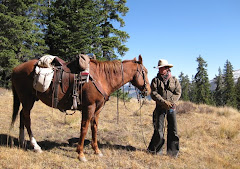 Winter is coming early. The last of our horses who will be spending the following half a year down on pasture in the valley below our mountain have been sent off. The remaining six horses are stuck up here with me. Really stuck. Our ranch is located at an elevation of nearly 10,000, though fortunately with good southern exposure – and Colorado does get sun in the winter. And snow. That snow gets deep; our road becomes closed to anything but skis and snowmobiles, and our horses become confined to the single track they lay down, packing their way through storm after storm, until their trails are set for the season, channels of packed snow they learn to follow like a good book. One step off could mean disaster. Imagine a horse stuck in four feet of compressed snow. It’s not the pretty, fluffy picturesque romp you see in the old westerns. In our reality, it looks like that only for the first snow or two of the season. After that, “falling in” for a horse deems a situation worthy of panic. It is a matter of survival. They know. They do not belong up here, but are completely dependant upon my care. I do my best to provide, and know it is never enough.
Winter is coming early. The last of our horses who will be spending the following half a year down on pasture in the valley below our mountain have been sent off. The remaining six horses are stuck up here with me. Really stuck. Our ranch is located at an elevation of nearly 10,000, though fortunately with good southern exposure – and Colorado does get sun in the winter. And snow. That snow gets deep; our road becomes closed to anything but skis and snowmobiles, and our horses become confined to the single track they lay down, packing their way through storm after storm, until their trails are set for the season, channels of packed snow they learn to follow like a good book. One step off could mean disaster. Imagine a horse stuck in four feet of compressed snow. It’s not the pretty, fluffy picturesque romp you see in the old westerns. In our reality, it looks like that only for the first snow or two of the season. After that, “falling in” for a horse deems a situation worthy of panic. It is a matter of survival. They know. They do not belong up here, but are completely dependant upon my care. I do my best to provide, and know it is never enough.Every year around this time we open the gates and let the horses run together in their limited and rapidly reducing environment. And for half the year, the stallion, Flying Crow, is allowed to run with his herd. A beautiful as sight as any I have seen, natural and wild and free.
This year, his herd is reduced. It is small and economical. He has his two best mares, a two-year old gelded son, and two yearlings (a colt and a filly). When I opened the gate, he stepped out of his ½ acre paddock, walked 15 feet, put his head down, and grazed. Ah, the idyllic vision as he is surrounded by his mares and offspring.
But Utopia didn’t last long. About a half hour. Then he took to chasing the small herd around and around, in and out of open gates, all over the 20 acres of pasture. Finally, he cornered the mares and yearlings. They submitted. They were fine.
But the 2-year old was kept out. Ran off. Not allowed near. Not near water, not near hay. Certainly not near the other horses. Why?
This 2-year old, Tresjur is his name and he’ll be the subject of our next post, was suspected of maturing last year, as a yearling, a bit early from my limited experience. After noticing the stallion then chasing the youngster through the fence two times, I called the vet out. It was considered premature, but they were there. He was promptly gelded. We assumed with the loss of his testicles would be the end of the problems. Though we hadn’t tested the waters yet.
I believe in allowing horses to be horses, and let them work things out themselves when they safely and reasonably can. After a night of being chased off, Tresjur was found hiding in the willows the following morning, trembling. Fortunately not a scratch or a bite mark on him.
Crow was put off in a separate field, Tresjur returned to his family and friends unmolested. A snow storm now covers the mountain. Operations shut down for the day. We will regroup and reconsider and figure out how to reintroduce Crow to his herd on a better day, in a better way. Any suggestions? Any one else have experiences they can share to provide insight to a stallions behavior? I have read those who believe stallions are unpredictable. I beg to differ. They are remarkably predictable beings. IF we understand who and what a stallion is, what their needs are, what drives them. I am still learning.
In the meanwhile, I worry for my poor Tresjur, to have been what appears to us unknowing humans unnecessarily harassed by his sire. And now, poor Crow, for being denied the chance to run free with his herd. It will happen again. Later and safer. Time to regroup. After the snow melts.





